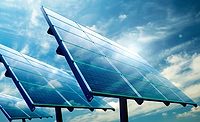As part of its SunShot Initiative, the U.S. Department of Energy (DOE) has announced $12 million to develop innovative, ultra-efficient solar devices that will close the gap with the theoretical efficiency limit, or the highest potential percentage of sunlight converted directly into electricity. Today, a sizable gap reportedly still exists between the efficiency of laboratory and commercial-scale solar photovoltaic (PV) cells and the predicted maximum efficiencies of different solar cell materials. Accelerating breakthroughs in solar cell conversion efficiency is expected to help continue to lower the overall cost of solar power; drive the development of advanced, low-cost PV modules; and fortify America’s leadership in the global solar energy market.
The new funding opportunity announced today builds on the SunShot Initiative’s FPACEI projects awarded in September 2011, which are aimed at eliminating the gap between the efficiencies of best prototype cells achieved in the laboratory and the efficiencies of typical cells produced on manufacturing lines. In the current solicitation, FPACEII seeks proposals from collaborative teams of researchers from national laboratories, universities, and industry that can develop materials model systems and fabricate prototype devices that achieve efficiencies near the Shockley-Queisser limit.
For additional information, visit https://eere-exchange.energy.gov.



